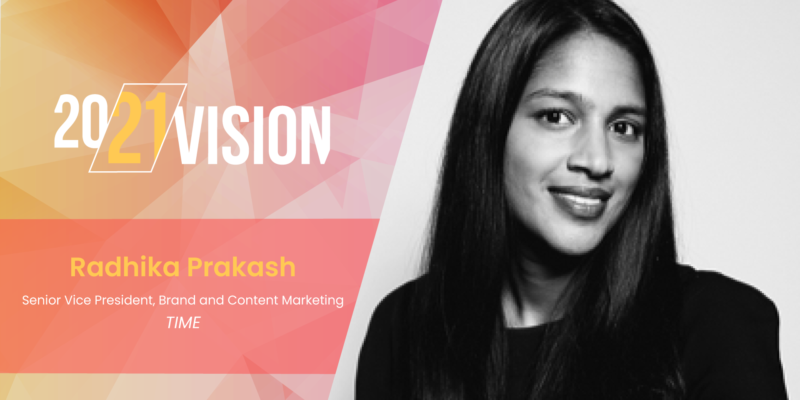For the first time in almost 100 years after being part of a conglomerate, TIME became a standalone brand again. Suddenly, the magazine was faced with a burning question:
What does TIME stand for and uniquely bring to the table as a brand?
Radhika Prakash, TIME’s Senior VP of Brand and Content Marketing, crafts TIME’s vision moving forward and brings that vision to clients in a way that is true to TIME’s values. We sat down with Radhika during the 20/21 Vision Summit Series to learn how she and her team build for TIME’s next 100 years and their strategies for working with clients to create authentic and compelling branded content.
Pivoting in Changing Times
When COVID turned everything upside down in 2020, Radhika put a hold on thinking more long-term and instead focused on TIME’s short-term plan. With so much negativity in the world, she and her team brainstormed ways they could restore hope, both editorially and as a brand.
They created a “Finding Hope” cover for the TIME100 COVID Special Report and featured stories of how influential people like Chef José Andrés brought good to society by feeding fresh, nourishing meals to quarantined cruise ship passengers and millions in need during the pandemic. Many of TIME’s clients wanted to be part of the conversation, but didn’t have content that they could immediately create. So Radhika and her team launched the TIME100 Talks — now a recurring series with changing topics — turning the cancelled 2020 TIME100 Gala into a public two-day online summit available where influential speakers like Dr. Fauci and John Legend shared different perspectives on the pandemic. Radhika’s team then invited clients to sponsor summit themes that were important to them, curating content with clients around those themes.
According to Radhika, it’s all about “how you pivot to the current moment but really still stay true and authentic to [your] brand.”
Evaluating User Feedback
After every TIME100 Talks, TIME sends a survey to attendants asking what they liked, didn’t like, and who they want to see. TIME takes that user feedback to generate future content. This ensures consumers feel like they’re getting value out of the event. It’s an iterative process: TIME changes the focus of each upcoming TIME100 Talks so that they can answer new consumer questions and also address what happened yesterday or today, as opposed to last week.
“We call ourselves the world’s oldest startup,” says Radhika. “We’re 97 years old, but we literally operate like a startup which has advantages. It allows us to be nimble and quick and react quickly to a lot of things that are happening right now.”
Building Trust
As is the case with most brands, building trust with audiences is a keystone of TIME’s communications strategy. But what differentiates TIME as a trustworthy brand?
“TIME doesn’t lean one way or the other drastically,” answers Radhika. “We never want people to say, ‘TIME told me this and that’s why I believe it.’” Rather, TIME aims to share what’s happening in the world so people can form their own opinions.
A major part of TIME’s vision for the future is finding new ways to leverage the brand’s neutral perspective to create knowledgeable conversations between people with differing opinions. For example, take the TIME Magazine cover:
“The TIME cover is such a conversation starter. How do we use that to our advantage — and not just as a magazine, but in digital also? If you go on our Instagram, you’ll see we animate the cover every week. We’re really thinking about going into the future, how do we evolve our brand to meet the different platforms but also give them the right content.”
Radhika Prakash
Attracting Sponsors
TIME’s reputation as a trusted brand and their ability to foster conversations on both sides of an issue is the reason why so many other brands want to sponsor their content.
Oftentimes brands want to be part of the conversation but aren’t ready to take a hard stance just yet. By sponsoring one of TIME’s themed talks, a brand can authentically be a part of the conversation about a topic they care about in a way that doesn’t feel forced.
Related Content: 10+ Ways Collaboration Strengthens Strategy
Harnessing Consumer Data & Insights
Consumer insights are a huge part of how TIME understands their clients and supports its ideas. TIME’s insights team uses first-party consumer data and syndicated data together as a stepping off point for crafting proposals for their clients.
“If we’re going to a tech client, we’ll look at what we see in tech, what we see with those types of decision makers on our site, what kind of content are they most interested in,” explains Radhika, “And it may not just be tech content we’re looking at — what are the adjacencies as well that they care about?”
After all, tech people aren’t just interested in tech. They might also be interested in sports, food, and national politics. Radhika and her team’s goal is to harness these data insights to put together an interesting proposal that is a combination of site sponsorship, regular digital media, and content ideas that help a tech company client come to life in those spaces.
To hear more about TIME’s brand and content strategy, watch Radhika’s full session below to learn how to:
- Pivot your brand messaging to changing situations while maintaining authenticity
- Implement flexible planning to take advantage of spontaneous collaboration opportunities
- Build brand trust with clients and consumers
- Strategize with sponsors to create compelling branded content
- Leverage user feedback and consumer data to inform future projects
Check out all the other on-demand presentations from The Strategy Summit here.




